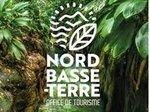Galbas trail
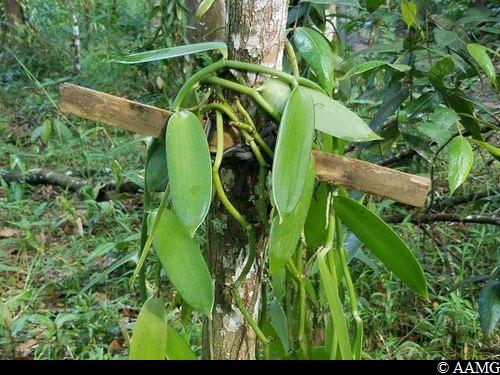
Sainte-Rose
Galbas trail
Easy
2h
3,4km
+209m
-211m
Loop
PR (short hike network)
Embed this item to access it offline
10 points of interest

panneau au départ - C.Lesponne  Information board
Information boardStarting panel
You will see the panel introducing two neighbouring trails: the Saut des Trois Cornes trail and the Tête Allègre trail. The start of the Galbas circuit is shared by both of these trails. Please note, this trail is not mentioned on the starting panel.
On the way, you will see signs guiding you along the Galbas trail.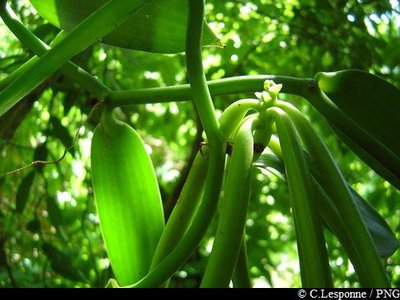
gousses de vanille - PNG  Agricultural landscape
Agricultural landscapeVanilla
There are more and more agroforestry projects, and vanilla is one of the main crops, with half of the vanilla farmers working as franchisees. The ONF authorises franchises or "concessions", which are drawn up to respect technical and environmental provisions related to forest management.
Vanilla is an orchid that likes shaded, cool and humid environments. Growing it is tricky and time-consuming. Since there are no pollinating insects in the archipelago, pollination is carried out by hand.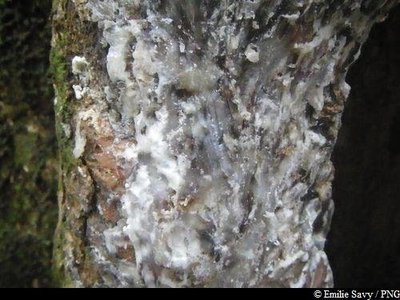
PNG  Flora
FloraCandlewood
Candlewood (Dacryodes excelsa) can grow up to 35 metres in height. From the trunk and roots a white sap with a strong smell of resin seeps out when cut. The sap is traditionally used as incense or to light fires, since it burns very slowly, whatever the humidity level. It is believed it can chase away evil spirits. Candlewood trunks were used by native Americans to make canoes (kanawa), and in many tropical countries today, such as Dominica, the trunks are used by coastal populations to make fishing boats. Wood pigeons are fond of the seeds from the tree.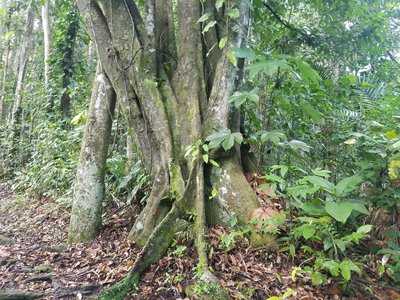
AAMG_1  Flora
FloraHaya blanca
Guatteria caribeae is a very straight tree, often with more than one trunk. It has blackish bark and dangling branches. The tree's berries are pulpy and black. The bark is used to make rope, and the wood to make ships' masts. It is still used today to make traditional sailing boats in Guadeloupe (kanot).
Bois bandé (écorce) - PNG  Flora
Flora"Bwa Bandé"
Richeria grandis is known as "Bwa Bandé" locally. This is a very tall species that can be recognised with its tough leaves and reddy-brown bark. Its fruits are very specific, forming little capsules that look like green raisins. They mass together in large numbers on the branches. The "bwa-bandé" is unfortunately often the victim of illegal cuttings, since its bark is renowned as an aphrodisiac. The wood was once used to make frameworks and in carpentry
panneau - AAMG  Information board
Information boardSignpost
First intersection with the Boucle de Tête Allègre trail. Turn right to follow "Sofaïa" / Galbas.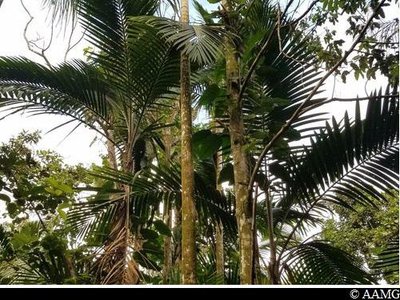
Palmier montagne - AAMG  Flora
FloraSierran palm
The Sierran palm (Prestaea montana) has no trunk but only a stipe, like the fern. It can live both in the hygrophile or rain forest (where it can grow up to about ten metres in height) and at high altitude (where it does not grow over two metres).
Please note: intersection towards the Trois Cornes Fall (Sofaïa). Continue to the right and begin the descent along the Galbas trail.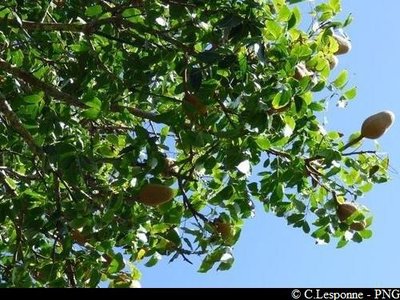
Mahogany grandes feuilles - PNG  Flora
FloraWest Indian mahogany
The West Indian mahogany (Swietennia macrophylla) is a perennial tree with a large, straight, cylindrical bole. It has little yellowy green blossom. The species was introduced into the island for its wood. The wood is much in demand in cabinet-making for its hardness and colours, which leads to over-exploitation in its native area. It appears in appendix II of the list of endangered species (Washington convention).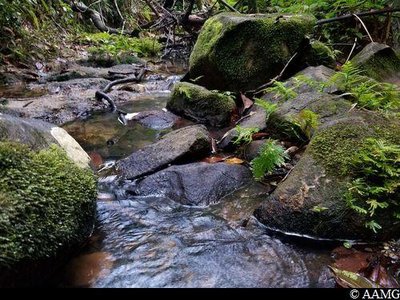
AAMG  River and waterfall
River and waterfallGully
The Basse-Terre mountain range has a network of countless gullies which constitute drainage basins for the main rivers. The Grand Boucan gully is one of the rivers periodically supplying water to the famous Grande Rivière in Goyaves.
Siguine blanche - AAMG  Flora
FloraPhilodendron giganteum
The Philodendron giganteum is an epiphyte. It is easily recognisable due to its leaves resembling elephant ears and its root system, with one part securing it to the host plant and another growing down towards the ground. The roots are used as raw materials in local wickerwork. Epiphytes are plants living on other plants. In Guadeloupe, they are remarkably abundant in the thick rain forests. They attach to the trunks, branches and leaves of their hosts, forming real hanging gardens to enchant visitors. Although some of them can grow on the ground, they generally grow higher up in forests because there is more light and higher humidity levels (over 80%).
Description
Follow the gently climbing forest path after the starting panel for the "Tête Allègre" trail. After the vanilla plantation, the terrain is hilly. Then gradually the slope climbs to become very steep before the intersection with the Tête Allègre trail. Turn right at the panel, then right again at the intersection with Le Saut des Trois Cornes. Continue along the path winding its way down between the trees and several blocks of stone. Cross the gully, then walk along it. At the intersection head to the right (take care, to the left there is a forest track), walking up the little slope before going down and crossing a second gully.
Go up the slope on the earth steps, turn right, then follow the crest as far as the forest path. Turn right again to return to the starting point.
Go up the slope on the earth steps, turn right, then follow the crest as far as the forest path. Turn right again to return to the starting point.
- Departure : At the end of the La Muraille forest road, Sainte-Rose.
- Arrival : At the end of the La Muraille forest road, Sainte-Rose.
- Towns crossed : Sainte-Rose
Altimetric profile
Recommandations
The trail is slippery and very muddy in rainy weather.
Don't begin the hike after 3 pm, since night falls quickly in the undergrowth.
In this natural setting, you should be particularly careful and alert, since Guadeloupe is subject to natural risks. It is vital to act in a responsible way, so that everyone can enjoy the hike!
Please note: unsupervised car park.
Don't begin the hike after 3 pm, since night falls quickly in the undergrowth.
In this natural setting, you should be particularly careful and alert, since Guadeloupe is subject to natural risks. It is vital to act in a responsible way, so that everyone can enjoy the hike!
Please note: unsupervised car park.
Information desks
Place tricolore, 97115 Sainte-Rose
le bourg, 97126 Deshaies
Access and parking
GPS starting point: 16,27685° N - Long : 61,71685° W.
---
In Sainte-Rose: head for the La Boucan section, at the roundabout leave the N2 and head for the "Bis" section. When you get to the crossroads, turn left towards the Domaine de Séverin and the Cadet section.
Turn left to go round the Domaine de Séverin; follow the road, then the forest path as far as the sign for the start of the trail.
---
In Sainte-Rose: head for the La Boucan section, at the roundabout leave the N2 and head for the "Bis" section. When you get to the crossroads, turn left towards the Domaine de Séverin and the Cadet section.
Turn left to go round the Domaine de Séverin; follow the road, then the forest path as far as the sign for the start of the trail.
Parking :
At the side of the forest road.
Source
Rando Guadeloupehttps://www.randoguadeloupe.gp/
Report a problem or an error
If you have found an error on this page or if you have noticed any problems during your hike, please report them to us here:


